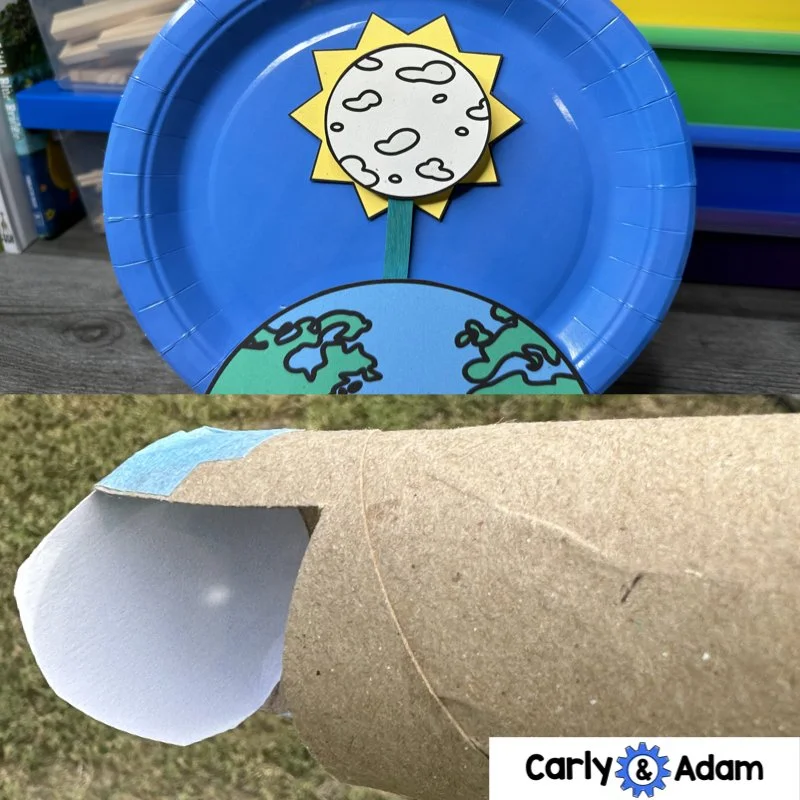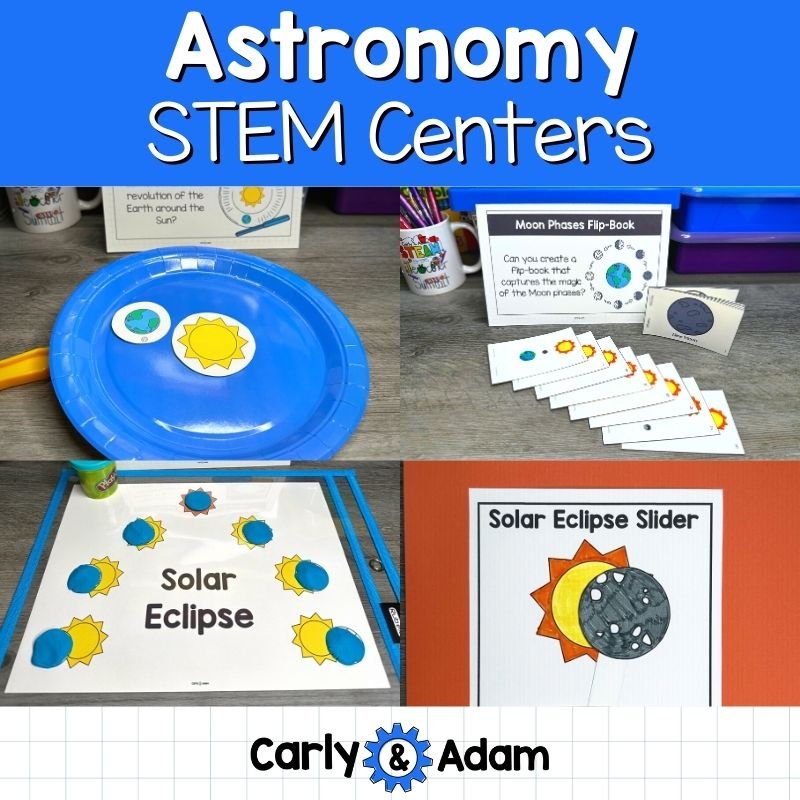Solar Eclipse STEM Challenge and Activities
Solar eclipses are awe-inspiring celestial events that captivate people's imagination and curiosity. They offer a unique opportunity for educators and parents to engage children in hands-on STEM (Science, Technology, Engineering, and Mathematics) activities that not only make learning fun but also deepen their understanding of the solar system.
In this blog post, we'll explore exciting STEM challenges and activities related to solar eclipses, including creating a paper plate model and constructing a solar eclipse viewer.
What to expend this lesson into more astronomy concepts (moon phases, constellations, and more)? Check out our Astronomy STEM Centers!
Understanding Solar Eclipses
Before diving into the activities, it's essential to provide a basic understanding of what a solar eclipse is. A solar eclipse occurs when the moon passes between the sun and Earth, temporarily blocking the sun's light.
There are two main types of solar eclipses: partial and total. During a partial solar eclipse, only a portion of the sun is obscured, while a total solar eclipse occurs when the sun is entirely covered by the moon.
Now, let's explore some engaging STEM activities to help children comprehend and appreciate this celestial phenomenon. The first activity we will explore is a paper plate solar eclipse model.
Activity #1: Paper Plate Solar Eclipse Model
To complete this activity you will need the following materials:
Material List:
Paper Plate
Glue or Tape
Scissors and/or X-Acto Knife
Popsicle Stick
Begin by discussing the different parts of a solar eclipse, including the sun, moon, and Earth's position during the event. Explain the concept of the moon casting a shadow on Earth.
Begin by cutting out the Earth, Sun, and Moon. Then cut a slice in the paper plate. This can be done before class with an X-Acto knife or with scissors.
Apply glue to the right and left sides of the Earth and then glue to the bottom of the plate so it hides the slit but is not glued over it.
Glue the sun at the top of the plate. Glue the moon to the top of the popsicle stick.
Slide the open end of the popsicle stick in the slit and use your hand to move the moon across the path of the sun to create a solar eclipse.
The paper plate model and solar eclipse viewer activities can be found in our TPT store. You can also get access to all of our resources when you join the STEM Teachers Club Membership.
Activity #2: Eclipse Viewer
To complete this activity you will need the following materials:
Material List:
White Index Card
Pencil or Pen
Tape
Paper Towel Roll
Aluminum Foil
Scissors
Begin by explaining to students that we will be learning about a phenomenon know as a solar eclipse. Use the included anchor chart to explain what happens during a solar eclipse.
Remind students that they should never look directly at the sun without proper eye protection during a solar eclipse, as it can cause severe eye damage.
Using a simple viewer allows you to observe the eclipse safely by projecting an image of the sun. Guide students through the process to make their own solar eclipse viewer.
Measure the circumference of the paper towel roll on the index card. Cut along the line. Measure the circumference of the paper towel roll on the foil and cut about a half of an inch larger so there is room to fold down the sides. Lastly, cut about a one inch square out of one end of the paper towel roll.
Place the aluminum foil on the uncut end of the paper towel roll. Press the edges down and then tape around.
Place the index card on the cut side and tape it in place.
Use a pencil or pen to poke a small hole in the aluminum foil.
To use the viewer, point the aluminum foil end towards the sun. Look at the inside of the index card to see the eclipse projected.
The paper plate model and solar eclipse viewer activities can be found in our TPT store. You can also get access to all of our resources when you join the STEM Teachers Club Membership.
Engaging in STEM activities related to solar eclipses can be an exciting way for children to learn about astronomy, physics, and the natural world. These activities not only educate them about the science behind solar eclipses but also foster creativity, critical thinking, and problem-solving skills.
So, the next time a solar eclipse graces the sky, consider trying out these hands-on projects with your young astronomers. It's a fantastic way to make learning about the cosmos an unforgettable experience.
Want more engaging activities to teach about the solar eclipse?
Check out our Astronomy STEM Centers! It includes 15 hands-on centers to teach about the sun, moon phases, constellations, and more!
Have more questions or need additional resources?
You can get all 250+ STEM Challenges by Carly and Adam as part of the STEM Teachers Club Membership. Save $5 on your first month using coupon Code: CarlyAndAdamBlog.
We hope you have found this blog post helpful. To stay connected with Carly and Adam's teaching tips and classroom freebies be sure to follow us on Facebook, Pinterest, Teachers Pay Teachers, and subscribe to our blog!











